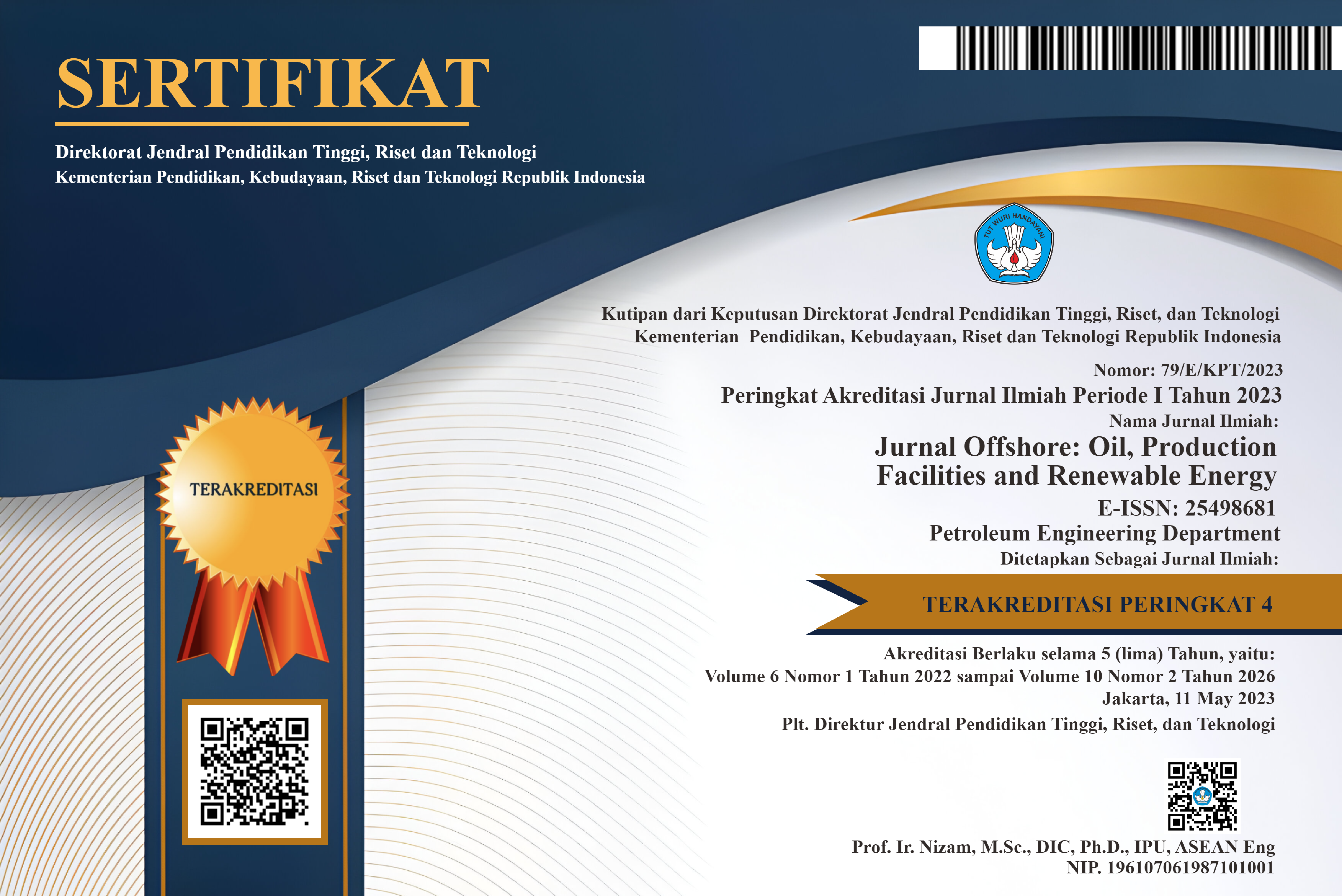DESAIN PROTOTYPE GASIFIER BIOMASS PORTABLE UNTUK MELISTRIKI DAERAH 3T
DOI:
https://doi.org/10.30588/jo.v5i2.933Keywords:
biomas gasifier portable, updraft, daerah 3TAbstract
Portable biomass gasifier merupakan Pusat Listrik Tenaga (PLT) Biomassa yang didesain dengan tujuan mudah dipindahkan untuk menjangkau daerah 3T (terluar, tertinggal dan terpencil). Komponen utama dari PLT Biomassa ini antara lain: reaktor, siklon, gas cooler, filter dan genset, sedangkan komponen pendukung antara lain: trailer, blower, water pump, thermocouple dan flare. Berdasarkan perhitungan beban maksimum dari gasifier ini sebesar 16.88 kW. Dengan bahan baku biomassa tempurung kelapa, pada beban 5 kW gasifier ini membutuhan biomassa dan udara sebesar 16 kg dan 8.44 m3 dan dapat beroperasi selama 11.12 jam. Konstruksi mobile biomass gasifier dipasang diatas trailer bertujuan untuk mempermudah pindah tempat sehingga mudah menjangkau daerah 3T. Penggunaan gas cooler tipe shell & tube counter flow mencegah terjadinya pencampuran kondensasi tar dengan media pendingin. Hal ini menjadikan gasifier ini mudah dalam penanganan tar sehingga aman terhadap lingkungan. Disamping itu pencampuran uap dari media pendingin dengan gas produk yang dapat dihindari sehingga kualitas gas produk dan efisiensi gasifier cenderung lebih baik. Berdasarkan perhitungan pada beban 5, 6 dan 7 kW, suhu gas produk setelah melewati gas cooler berkisar 54.88 sampai 55.10 °C. Pada suhu tersebut sangat mungkin terjadi kondensasi tar dan uap air hasil pembakaran yang menjadikan zat tersebut terpisah dari gas produk gasifikasi, seperti diketahui bahwa tar dan uap air merupakan zat pengotor dalam produk gasifikasi, sehingga dengan berkurangnya tar dan uap air dalam gas produk gasifikasi akan meningkatkan nilai kalor gas produk dan efisiensi gasifikasi.
References
Akhbarifar, S., & Shirvani, M. (2019). Improving cyclone efficiency for small particles. Chemical Engineering Research and Design, 147, 483–492. https://doi.org/10.1016/j.cherd.2019.05.026
Ayyadurai, S., Schoenmakers, L., & Hernández, J. J. (2017). Mass and energy analysis of a 60kWth updraft gasifier using large size biomass. Fuel, 187, 356–366. https://doi.org/10.1016/j.fuel.2016.09.080
Basu, P. (2018). Biomass Gasification, Pyrolysis and Torrefaction: Practical Design and Theory. Academic Press.
Cerinski, D., Ferreiro, A. I., Baleta, J., Costa, M., Zimbardi, F., Cerone, N., & Wang, J. (2021). Modelling the biomass updraft gasification process using the combination of a pyrolysis kinetic model and a thermodynamic equilibrium model. Energy Reports. https://doi.org/10.1016/j.egyr.2021.05.079
Cerone, N., Zimbardi, F., Contuzzi, L., Baleta, J., Cerinski, D., & Skvorčinskienė, R. (2020). Experimental investigation of syngas composition variation along updraft fixed bed gasifier. Energy Conversion and Management, 221, 113116. https://doi.org/10.1016/j.enconman.2020.113116
Chen, Q., Hao, J.-H., & Zhao, T. (2017). An alternative energy flow model for analysis and optimization of heat transfer systems. International Journal of Heat and Mass Transfer, 108, 712–720. https://doi.org/10.1016/j.ijheatmasstransfer.2016.12.080
Ding, L., Yoshikawa, K., Fukuhara, M., Kowata, Y., Nakamura, S., Xin, D., & Muhan, L. (2018). Development of an ultra-small biomass gasification and power generation system: Part 2. Gasification characteristics of carbonized pellets/briquettes in a pilot-scale updraft fixed bed gasifier. Fuel, 220, 210–219. https://doi.org/10.1016/j.fuel.2018.01.080
Ding, L., Yoshikawa, K., Fukuhara, M., Xin, D., & Muhan, L. (2017). Development of an ultra-small biomass gasification and power generation system: Part 1. A novel carbonization process and optimization of pelletization of carbonized wood char. Fuel, 210, 674–683. https://doi.org/10.1016/j.fuel.2017.09.033
Halil I. Erol. (2019). Experimental and numerical study of Stairmand cyclone separators: A comparison of the results of small-scale and large-scale cyclones. Heat and Mass Transfer of Springer Link. https://doi.org/10.1007/s00231-019-02589-y
Heidenreich, S., Müller, M., & Foscolo, P. U. (2016). Advanced Biomass Gasification: New Concepts for Efficiency Increase and Product Flexibility. Academic Press.
Indrawan, N., Thapa, S., Bhoi, P. R., Huhnke, R. L., & Kumar, A. (2017). Engine power generation and emission performance of syngas generated from low-density biomass. Energy Conversion and Management, 148, 593–603. https://doi.org/10.1016/j.enconman.2017.05.066
R. Preetha Devi. (2017). Design and Development of Updraft Gasifier Using Solid Biomass. International Journal of Current Microbiology and Applied Sciences. https://doi.org/10.20546/ijcmas.2017.604.021
Sansaniwal, S. K., Rosen, M. A., & Tyagi, S. K. (2017). Global challenges in the sustainable development of biomass gasification: An overview. Renewable and Sustainable Energy Reviews, 80, 23–43. https://doi.org/10.1016/j.rser.2017.05.215
Venkatesh, G., Ramakrishna Reddy, P., & Kotari, S. (2017). Generation of producer gas using coconut shells and sugar cane bagasse in updraft gasifier. Materials Today: Proceedings, 4(8), 9203–9209. https://doi.org/10.1016/j.matpr.2017.07.278
Zhang, Y., Wan, L., Guan, J., Xiong, Q., Zhang, S., & Jin, X. (2020). A Review on Biomass Gasification: Effect of Main Parameters on Char Generation and Reaction. Energy & Fuels, 34(11), 13438–13455. https://doi.org/10.1021/acs.energyfuels.0c02900
Downloads
Published
How to Cite
Issue
Section
License
Authors retain copyright and grant the Jurnal Offshore right of first publication with the work simultaneously licensed under a Creative Commons Attribution 4.0 International License that allows others to share (copy and redistribute the material in any medium or format) and adapt (remix, transform, and build upon the material) the work for any purpose, even commercially with an acknowledgement of the work's authorship and initial publication in Jurnal Offshore. Authors are able to enter into separate, additional contractual arrangements for the non-exclusive distribution of the journal's published version of the work (e.g., post it to an institutional repository or publish it in a book), with an acknowledgement of its initial publication in Jurnal Offshore. Authors are permitted and encouraged to post their work online (e.g., in institutional repositories or on their website) prior to and during the submission process, as it can lead to productive exchanges, as well as earlier and greater citation of published work (See The Effect of Open Access).















